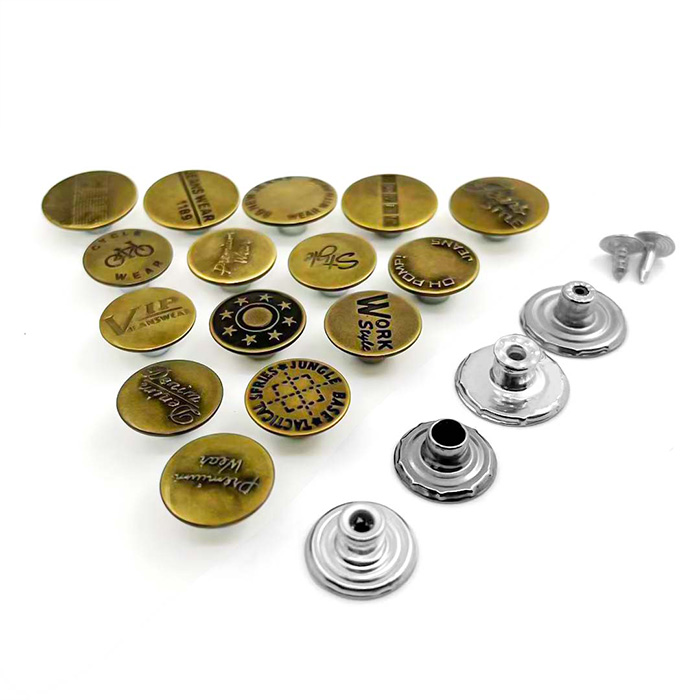Metal buttons are common decorative and functional elements in clothing and accessories. There are various types of metal buttons based on materials, shapes, craftsmanship, and applications. Below is an introduction to the different types of metal buttons.

1. Copper Buttons
- Material: Made from copper, often treated with surface finishes like gold plating, silver plating, or nickel plating.
- Features: Copper buttons are known for their good corrosion resistance and long lifespan. They have a warm tone and are suitable for vintage or classic-style garments. Over time, copper may naturally oxidize, forming a unique green patina, adding to its vintage appeal.
- Applications: Widely used in high-end coats, workwear, denim garments, and custom pieces from fashion brands.
2. Stainless Steel Buttons
- Material: Made from stainless steel, which is known for its high strength and corrosion resistance.
- Features: Stainless steel buttons are smooth, shiny, and highly resistant to oxidation. They are ideal for humid and marine environments, as they will not rust, ensuring long durability.
- Applications: Commonly used in workwear, outerwear, sportswear, outdoor clothing, and other high-strength applications.
3. Zinc Alloy Buttons
- Material: Made from a blend of zinc and other metals, such as copper or aluminum. Zinc alloy buttons are known for their good moldability and ease of processing.
- Features: Zinc alloy buttons are lightweight and can be molded into intricate shapes. They are often plated to achieve various metallic finishes such as gold, silver, or black. While zinc alloy buttons have a smooth and modern look, they are slightly less corrosion-resistant compared to copper or stainless steel.
- Applications: Widely used in mid to high-end fashion apparel, casual wear, leather goods, and bags.
4. Aluminum Alloy Buttons
- Material: Made from aluminum alloy, which consists of aluminum combined with other metals like silicon or magnesium.
- Features: Aluminum alloy buttons are lightweight and have good processing characteristics, allowing them to be shaped into fine details. They are resistant to rust, and although their strength and hardness are lower, they still perform well in many applications.
- Applications: Commonly used in lightweight clothing and accessories like T-shirts, shirts, bags, and other casual wear.
5. Copper-Gold Plated Buttons
- Material: Typically made of copper and treated with a gold plating process, covering the surface with a gold layer.
- Features: Copper-gold plated buttons offer a luxurious and high-end appearance with a shiny golden finish. They have good corrosion resistance but are not as durable as stainless steel.
- Applications: Often used in high-end dresses, men's suits, and premium outerwear.
6. Cast Iron Buttons
- Material: Made from cast iron, sometimes treated with spray coatings or electroplating.
- Features: Cast iron buttons have a heavy feel, and they are usually darker in color (such as black or dark brown). They are durable and robust but can rust, making them unsuitable for garments that require frequent washing.
- Applications: Common in workwear, uniforms, and vintage-style clothing.
7. Nickel Alloy Buttons
- Material: Made from nickel and other metal alloys, such as copper, offering high hardness and strength.
- Features: Nickel alloy buttons are smooth, durable, and highly resistant to corrosion. They have a shiny finish and are suitable for clothing items that need to maintain their appearance over time.
- Applications: Frequently used in high-end men's shirts, outerwear, leather goods, and other luxury design products.
8. Silver/Gold Plated Buttons
- Material: Made from other metals (such as copper or zinc alloy) and coated with silver or gold plating.
- Features: These buttons have a sophisticated and decorative look, often enhancing the garment's overall luxury feel. The plating improves their corrosion resistance and appearance.
- Applications: Common in luxury fashion garments, uniforms, dresses, and high-end accessories.
9. Gemstone-Embedded Buttons
- Material: Typically made from metals (such as copper, stainless steel, or zinc alloy) and combined with gemstones, diamonds, or crystals.
- Features: These buttons are highly decorative and feature sparkling gemstones or crystals, adding luxury and glamour to the garment. They are mostly used for formal occasions.
- Applications: Common in high-end custom garments, evening dresses, and jewelry pieces.
10. Vintage-Style Metal Buttons
- Material: Typically made from copper or zinc alloy and treated with a special oxidization process to achieve an aged or vintage look.
- Features: Vintage-style metal buttons have a unique, historic feel, often used to add individuality to garments. They are especially popular in retro or traditional clothing designs.
- Applications: Used in vintage-style coats, pants, vests, skirts, and traditional-style clothing.
Conclusion
Metal buttons are not only functional but also serve as a decorative element in garment design. With various materials, finishes, and designs available, they can be used in a wide range of fashion and accessory products. When choosing metal buttons, it is essential to consider the garment's intended use, durability requirements, appearance, and budget.
Comments on “An Introduction to Different Types of Metal Buttons”